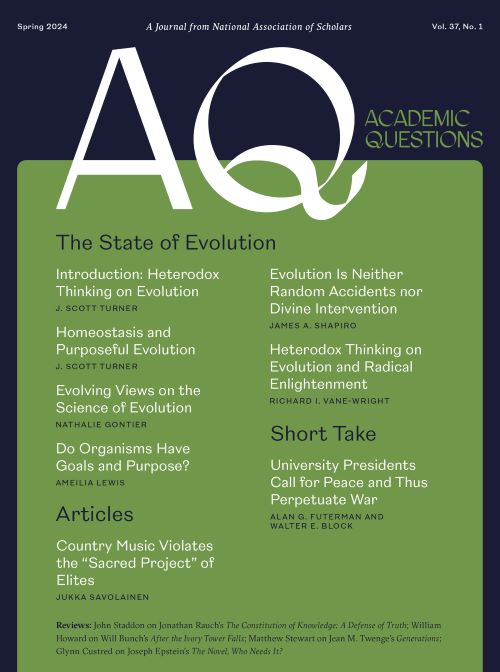Generations: The Real Differences Between Gen Z, Millennials, and Silents—and What They Mean for America’s Future, Jean M. Twenge, Simon and Schuster, 2023, 554 pp., $32.50 hardcover.
Jean Twenge has devoted her professional life to generational studies. Professor of psychology at San Diego State University, she is a productive and respected academic who also has the media presence and communication skills to be called a public intellectual. Though trained as a psychologist, she has produced a body of work with a decidedly sociological slant. Her research mission has long been to describe the shared tendencies and defining characteristics of age cohorts. “The era when you were born has a substantial influence on your behaviors, attitudes, values and personality traits,” Twenge avers. “In fact, when you were born has a larger effect on your personality and attitudes than the family who raised you does.” (2) Her latest book, Generations, describes six living United States generational cohorts separated by increments of fourteen to twenty-one years, starting with the Silent Generation (born 1925-1945) and ending with the oncoming generation that she has dubbed the Polars (born 2013-2029). Sandwiched in between are the Boomers, Gen X, Millennials, and, of greatest relevance to teachers and professors, Gen Z, which in her previous book devoted exclusively to that group, Twenge tellingly dubbed iGen.
Twenge has called Generations her magnum opus. It draws on twenty-one large-scale surveys and datasets gathering information from thirty-nine million respondents, mostly from the United States. She explores how each generation shares beliefs, behaviors, values, and experiences that define the cohort. She also examines how historical events, cultural shifts, and technological changes have shaped and influenced each generation. While previous generational studies imputed major historical events (the Great Depression, World War II, Vietnam) as the primary molders of generations, Twenge repeatedly avers that technological developments are the main drivers.
Her first chapter, “The How and Why of Generations,” includes a review of previous scholarship, including the work of “historical-events” scholars such as Karl Mannheim and “generational-cycles” scholars such as William Strauss and Neil Howe. While conceding the obvious importance of shared major historical events—the Great Recession of 2008-2009 is a typical example—Twenge repeatedly emphasizes the impact of technological surges, “the ways in which life today is so different from life twenty years ago, fifty years ago, or one hundred years ago.” (5) Technology is conceived of here in its broadest sense, referring to any practical device meant to assist in tasks or to augment human activity. The category is not solely comprised of internet-related electronic gadgetry, but includes the birth control pill, antibiotics, air conditioning, modern appliances, the automobile, the elevator and more. Ask one hundred people-on-the-street to define the word technology and see how many so much as mention even one thing unrelated to computers and smart phones. Twenge’s reminder of these other life-changing technologies is a key point in an age saturated with Silicon Valley and social media.
Two overarching trends emerge across succeeding generations, which Twenge names “individualism” and “slower life.” By the latter term, she does not mean to say that the pace of life is slower, but that each succeeding generation moves more slowly through the stages of life. The term seems valid in view of such phenomena as prolonged adolescence, prolonged young adulthood, and deferral of marriage and children. In what is sure to be a hot-button quotation, Twenge states that “18-year-olds now look like 14-year-olds in previous generations.” (374) “Look like” is a loose formulation, but Gen Z’s lack of emotional resilience, its lack of practical coping skills, and its desire to be protected by adults (“come back in loco parentis, come back,” they would cry if they knew the term) have been remarked upon by many Gen X and Boomer authors, teachers, and employers. On the other hand, how does this immaturity square with the speeded-up pre-adolescent, tween years equally remarked upon, and often referred to as the loss of childhood? Twenge does not analyze this paradox.
Generations does not formulate a rigid definition of the other major trend, individualism, but applies the term in ways that pass the common-sense test. It refers to the ever-increasing emphasis on rights, to the explosion of consumeristic variety and choice in all facets of life, to the social freedoms and nonjudgmental approach towards “lifestyle” choices. On the other hand, it also refers to the diminution of social-compact expectations, the withering of a sense of duty to others and the reluctance to be inconvenienced by group demands or needs. Do your own thing. Activists of the present generation will undoubtedly take exception to this description. And doesn’t this socially conscious subset gain the headlines, nowhere more so than on the campus? Moreover, one set of findings directly undercuts this me-first, me-only description. Twenge herself reports that “helping others” and doing “a job that is worthwhile to society” are among questionnaire statements that get major air play with Gen Z respondents.1 Granted, Twenge is portraying major trends, not minority exceptions or individual variability. Still, readers will object that they know plenty of young adults who do not seem particularly self-centered, or that those they teach, mentor, or work beside are not all oversized babies.
Generations is filled with fascinating data, much of it charted and graphed, all of it accessible to the non-expert. The reader may find that a handful of visual representations charting the steady, generation-by-generation fall-off in religious conviction and worship attendance are worth a thousand words on that already known phenomenon. Turn to pages 297-300 to evaluate that possibility. Likewise, a large section of the chapter on Generation Z is devoted to analysis of its much-publicized mental health crises. In graph after graph, one sees undesirable trend lines soaring after 2008, the year that smart phones came on the market. Readers of AQ do not need reminding that correlations don’t prove causations, but the evidence here, while not scientifically conclusive, is a good deal more than merely suggestive.2 The most stunning irony is depicted on page 393, which registers the percentages of U.S. adolescents who report often feeling lonely or “left out.” The percentages nearly doubled between 2007 and 2021, the era when so-called social media came to reign supreme in teen lives. Meanwhile, actual in-person get-togethers amongst Gen Z teens have fallen off dramatically.
Aggrieved Millennials had already reacted to an Atlantic magazine excerpt published prior to the book’s release. Twenge terms this generation “the most planned and wanted generation in American history.” (231) It is a common conceit amongst this generation that the optimism and self-confidence of their youth have come a cropper to events, not least the Great Recession. Career trajectories leveled by that event, student debt and out-of-reach real estate prices are all cited as key factors making this generation the first not to surpass its parents in economic quality of life—or so it is thought. The data find one major problem with that bit of received wisdom: it is not true for a large majority of millennials, who are—contra received wisdom—further ahead economically than their predecessors at comparable stages of mid-life. While doing her best to present matters in non-judgmental language, close-by this finding, Twenge analyzes this generation’s psychological profile, finding prominent levels of narcissism in the millennial cohort. When faced with disappointment, those with both high self-regard and elevated expectations might be prone to play the victim, a social category much valorized in twenty-first century America. But when the victim is told that he or she is not a victim after all but is in truth part of a generational cohort humming right along, bitter denials may ensue.
Such contradictions of dominant narratives—and there are more than a few in this 500-page book—make for stimulating reading, and judged carefully, ought to foster better understanding of our fellow man. Yes, marketers and salesforce types will glom onto group-wide findings, sometimes with malignant results, but accurate perceptions of social forces are always to be preferred to guesswork, hasty generalizations, and false narratives, as long as generalizations do not solidify into prejudices. Used thoughtfully, the data and analyses in Generations can be the stuff of better understanding, better decision-making, and social improvement.
Matthew Stewart is associate professor of humanities and rhetoric at Boston University and the author of Modernism and Tradition in Ernest Hemingway’s In Our Time (2009); [email protected]. He last appeared in these pages in spring 2023 with the review essay “Where to the Woke,” a discussion of recent books on the ideological capture of universities.
1 Whether deeds match words regarding jobs-applied-for and jobs-taken is another matter. Look no further than Ivy League activists who shout progressive slogans and march for progressive causes, yet in high percentages seek out high paying jobs, social consciousness take the hindmost.
2 The dramatic effects are visually exaggerated by the vertical axes (used to plot the percentage of teens feeling X or suffering from Y) not being calibrated from 0-100, which seems unfortunate. Perhaps this choice was made to save page space rather than to heighten effects. In any event even if the axes were adjusted to register 0-100, the visual effects would remain dramatic.













